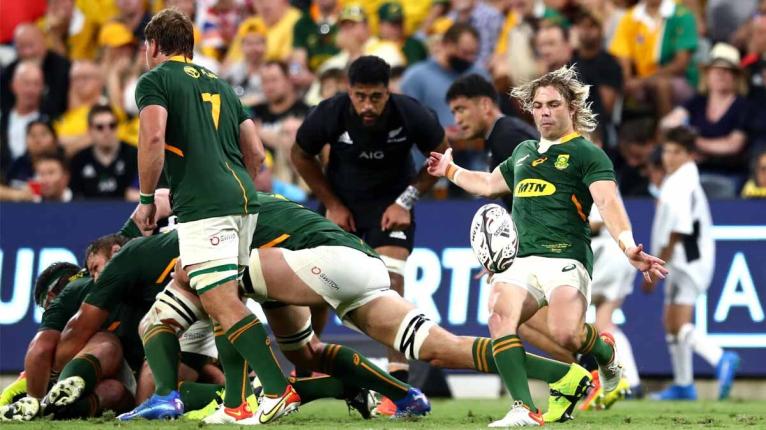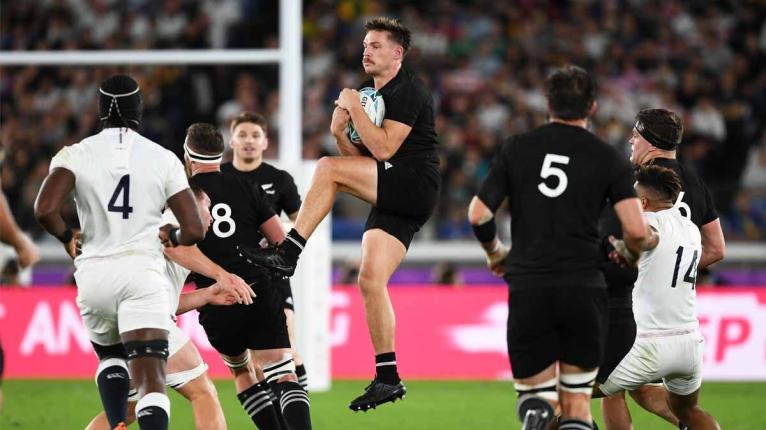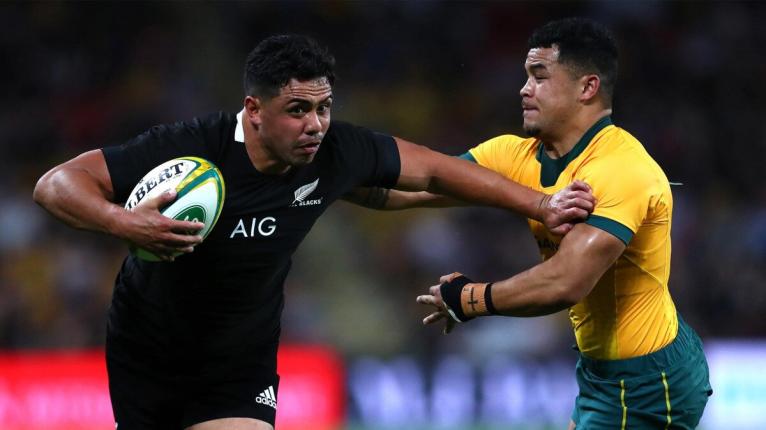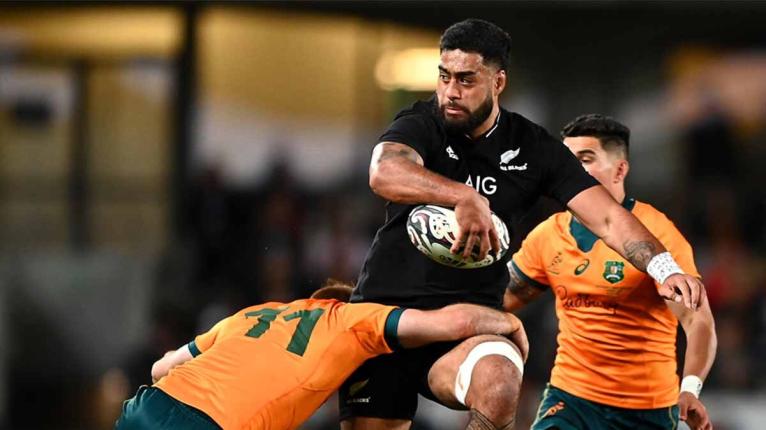It seemed, give or take the odd position, that early in the Rugby Championship, the All Blacks had discovered their best team.
And then they met South Africa in Townsville, and while the All Blacks emerged victorious, they were left with a nagging sense that they might have to re-evaluate a few players.
The Boks played zero rugby in their 19-17 defeat. They really didn’t give pass and catch any kind of a go as is borne out by the statistics which show South Africa kicked 38 times, passed 66 and ran 65.
This compares with the All Blacks who kicked 18 times, passed 142 and ran 97. Included in those kicking stats are two occasions when halfback Faf de Klerk hoisted the ball when he was standing just about inside the All Blacks 22.
It was an almost unprecedented strategic approach by the Boks. They have relied heavily on their box kicking, defence and the driving maul all year but never quite as heavily as they did in Townsville.

They simply refused to move the ball through the hands and the All Blacks didn’t even have to make 100 tackles. While it may have sat badly with the rugby romantics and those who crave a more expansive, free-flowing contest, there is no denying how effectively the Boks nullified the attacking threat of the All Blacks and how much pressure they exerted as witnessed by the 23 turnovers that New Zealand conceded.
For large periods of the game, the All Blacks were guilty of hurried and inaccurate execution. They dropped passes, overran each other, failed to commit enough numbers to the breakdown, lost lineouts, were penalised at scrums and couldn’t get their driving maul going forward.
But most significantly, they couldn’t – with the exception of Jordie Barrett – deal with the aerial threat the Boks presented. George Bridge, normally a strong performer in the air and picked for his accuracy in this department, spilt a few – including one absolute sitter that led to the Boks scoring their only try.
Will Jordan wasn’t overly comfortable in the air either, although was rarely tested, and the Boks’ excessive kicking highlighted real deficiencies in the All Blacks’ catching technique.
The Boks, by causing as many problems as they did, have forced the All Blacks to ask new questions about a handful of players as can be seen in the team they have picked to play the Gold Coast rematch.
“We’ve got to find some ways to combat that because they throw all sorts of different scenarios at us,” said man of the match Jordie Barrett who was the only player on the field who looked confident under the high ball.
“They are doing it from their attacking 22 and putting it on the head of isolated guys with plenty of chasers so it can be hard to deal with.
“I have never had that many contestable kicks to deal with in a game. It is pretty hard to combat, but it was a challenge I was kind of relishing.”
There wasn’t a facet of the game the All Blacks got right, or at least played with the intensity, accuracy and effectiveness they were hoping for and as such, it has forced an element of reassessing after mostly comfortable and impressive wins against Tonga, Fiji, Australia and Argentina.
The Boks, by causing as many problems as they did, have forced the All Blacks to ask new questions about a handful of players as can be seen in the team they have picked to play the Gold Coast rematch.

The back three was the area that troubled the selectors the most. In picking the team to play the first test, head coach Ian Foster explained the reasoning why Barrett, Jordan and Bridge had been selected ahead of Sevu Reece and Damian McKenzie: “It was a tough decision on Sevu particularly because he’s played really, really well.
“We probably felt that aerially, the other two were slightly ahead in terms of being a bit taller and we are expecting a bit of the aerial battle so probably came down to that sort of small margin – but that’s not to say that Sevu’s not good in that space either. So tough decision that one.”
For test two, Bridge and Jordan were left out. Reece came in, with Rieko Ioane shifted from centre to wing. There are a handful of things that says, the first being that Jordan and Bridge both have plenty of work to do on their respective aerial games.
Jordan is one of the great opportunists, capable of following the ball and using his electric pace to score tries on the strength of his anticipation, supremely good instincts and blinding pace.
Our back three weren’t at the level we needed them to be so it’s clearly a message that’s been sent.
Ian Foster on the performance against the Springboks
But he’s got work to do on his defence – positioning, work rate and high ball catching technique where he’s prone to sticking his arms out rather than committing to getting his whole body under the ball.
Bridge appears to have more of a confidence problem than anything else. He suffered a major injury last year which required surgery and a six-month lay-off and when he returned in March this year to Super Rugby, he needed an emergency removal of his appendix.
Perhaps what he needs more than anything else is an injury-free Super Rugby campaign next year to get more rugby into him and rebuild his confidence.
“Our back three weren’t at the level we needed them to be so it’s clearly a message that’s been sent,” Foster said in explaining the changes.
“It’s clearly an area we felt we needed to improve from last week so they’ve got a real focus for that.”
If the preferred back three for Foster earlier this year was Will Jordan and Sevu Reece on the wings and Damian McKenzie at fullback, it is now Ioane and Reece on the wings with Jordie Barrett in the No 15 jersey.

His preferred midfield is David Havili and Anton Lienert-Brown – the latter coming straight into the team to play the Boks on the Gold Coast after his hamstring finally came right.
Ioane has many of the attributes needed to be a world class centre, but his performance against the Boks in Townsville showed that he still has plenty to learn and that when the All Blacks head north in a few weeks, he’ll likely be used on the wing if Lienert-Brown is fit and available.
That’s why the All Blacks were so keen to play South Africa as their old foe asks questions that other teams don’t.
While Ioane looked comfortable against the Wallabies and Pumas at centre, he didn’t against South Africa’s intense line-speed and defensive pressure.
Rieko’s brother Akira is another who was flying along superbly until he met the Boks. He delivered two coming of age performances against the Wallabies in consecutive weeks in Bledisloe II and III and then was lost and clearly stunned against the Boks.
It was Ioane’s first test against the Boks and they rattled him. They used their tackling power to unsettle the All Blacks ball carriers, their height and smarts to disrupt the lineout and heft and technique to win the scrum battle.
The bruising, intimidating figure who had smashed big holes against Australia was nowhere to be seen in the face of the South African forward onslaught and mostly everyone had forgotten Ioane was playing in Townsville until he made his first significant act just before half-time, which was to drop the ball.
It was Ioane’s first test against the Boks and they rattled him. They used their tackling power to unsettle the All Blacks ball carriers, their height and smarts to disrupt the lineout and heft and technique to win the scrum battle.
And while it was uncomfortable at times for the All Blacks, Foster knows it was invaluable. It enabled him and his fellow coaches to see how a group of players not used to that sort of challenge were able to respond.
As he said: “We’ve got a lot of players who are still learning the art of international rugby. I’d put Akira in that boat; Brad Weber is the same, David Havili and even Jordie Barrett having a regular run at 15 and seeing what he learns from that.”
While Bridge and Jordan were dropped as a result of not meeting that challenge, Ioane, it was reasoned, deserved an opportunity to make immediate amends.

Ioane was a passenger for large tracts of the game, but the great hope is that having now gained a true sense of what the Springboks are all about, he’ll prove himself resourceful enough to be an influential force second time round.
He’ll need to be because Ethan Blackadder has shown that he’s ready to play anyone. He has such a simple, high energy, physical approach that he was as good against South Africa as he was the Pumas. Just as he was impressive when he met Fiji and the Wallabies.
If Ioane wants to stay in the No 6 shirt and not be a ‘horses for courses’ selection – the right choice to play against ruck and run teams like Australia but not real bruisers like England and South Africa – then he’ll need to deliver something more inspiring on the Gold Coast than he did in Townsville.
And of course, while the back three and the back row were the areas most exposed by the Boks, a light was also shone on the vexed issue of who is the right No 10 for the All Blacks.
Beauden Barrett had a so-so game after controlled and accurate performances against the Wallabies and Pumas and with Richie Mo’unga now out of quarantine and back with the team, that battle is likely to intensify over the next six weeks.
There is also going to be an injection of fresh legs once the team moves to Europe, with Sam Cane, Dane Coles, Sam Whitelock and Shannon Frizell all re-joining the team. With Aaron Smith also to come back – probably not this year but certainly next – the All Blacks are likely to end 2021 with different thoughts entirely about what their best side looks like than they did back in July.


Comments
Join free and tell us what you really think!
Sign up for free